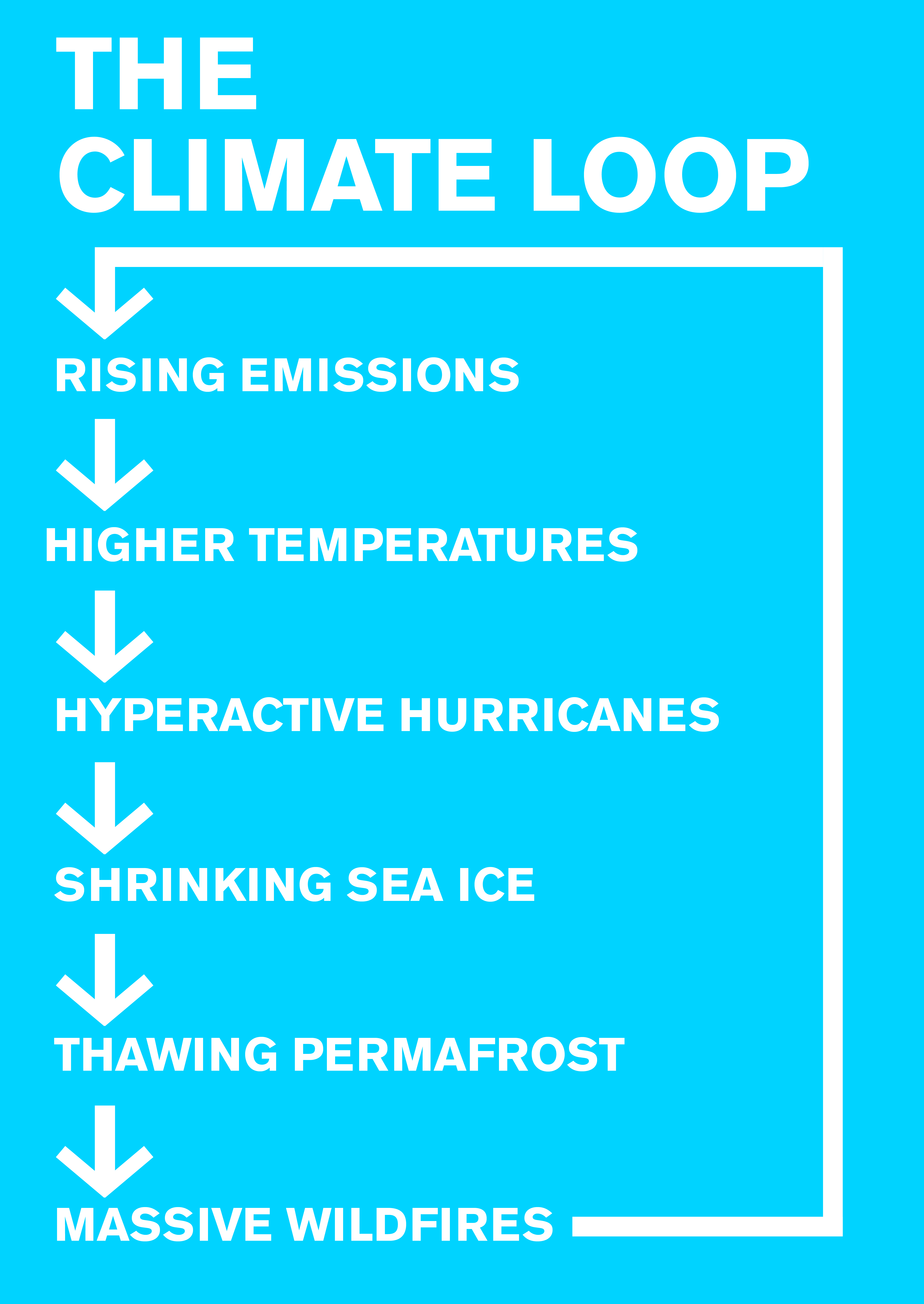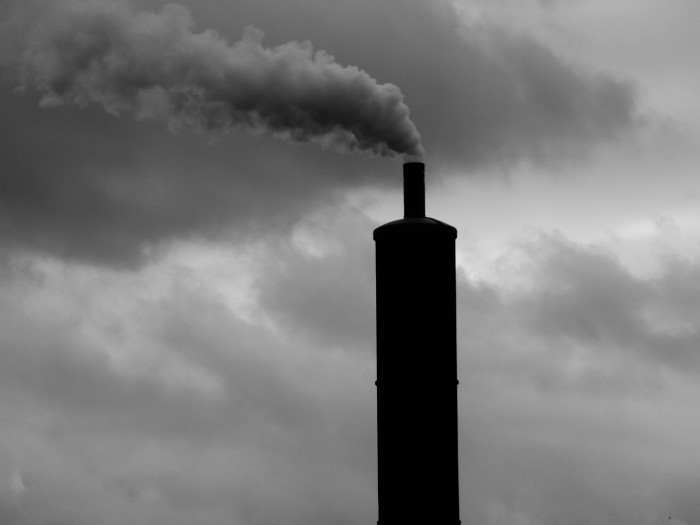The Year Climate Change Began to Spin Out of Control

For decades, scientists have warned that climate change would make extreme events like droughts, floods, hurricanes, and wildfires more frequent, more devastating, or both. In 2017, we got an up-close look at the raw ferocity of such an altered world as high-category hurricanes battered the East and Gulf coasts, and wind-whipped fires scorched the West (see “Did Climate Change Fuel California’s Devastating Fires? Probably”).
We’re also seeing with greater clarity how these dangers are interlinked, building upon one another toward perilous climate tipping points. And yet for all the growing risks, and the decades we’ve had to confront them, we have yet to address the problem in a meaningful way (see “Trump’s Five Biggest Energy Blunders in 2017”).
In fact, despite all our climate policies, global accords, solar advances, wind farms, hybrid cars, and Teslas, greenhouse-gas emissions are still moving in the wrong direction. And as long as we’re emitting any at all, we’re only making the problem worse.
Here are the five most worrisome climate developments we saw in 2017.
Emissions are rising again

After three relatively flat years, greenhouse-gas emissions from fossil fuels and industry picked up again in 2017, rising an estimated 2 percent, according to the Global Carbon Project. The shift was driven by rising carbon pollution in China and India, which more than offset a slight decline in the United States.
The news punctured tentative hopes that the recent flattening was solidifying into a trend. Among other things, it means that our collective climate efforts haven’t even prevented greenhouse-gas levels from increasing, at a point when we need to be radically cutting them. Keeping temperatures from rising beyond a dangerous 2 °C will require slashing emissions as much as 70 percent by midcentury, according to the U.N.’s Intergovernmental Panel on Climate Change.
At more than 400 parts per million, we’re already well beyond dangerous levels of carbon dioxide concentrations in the atmosphere, as climbing temperatures, melting ice caps, and extreme weather events have made clear.
In early November, the World Meteorological Organization declared that 2017 was likely to end up as “one of the three warmest years on record,” and the warmest one altogether that wasn’t influenced by an El Niño event. That also makes the global average temperature during 2013-2017 the hottest five-year average recorded.
Carbon dioxide can remain in the atmosphere for thousands of years and takes about a decade to reach its maximum warming effect. In other words, even with all the changes we’ve already seen, we have yet to experience the full impact of the carbon we spewed in 2008 and every year since. Each additional ton we emit going forward only increases the dangers of climate change, multiplying the economic, environmental, and human toll.
Worst-case scenarios look increasingly likely
The most alarming projections for global warming this century also seem to be the most reliable, according to a December study in Nature that compared climate models against what’s already happening in the atmosphere (see “Global Warming’s Worst-Case Projections Look Increasingly Likely”).
The paper concluded that worldwide temperatures could rise nearly 5 °C by the end of the century, 15 percent higher than the previous central estimate under the “business as usual” emissions scenario outlined by the U.N. Intergovernmental Panel on Climate Change.
The authors collected more than a decade’s worth of "top of atmosphere" satellite observations, measuring factors such as how much infrared radiation is escaping from Earth and how much sunlight clouds and snow reflect away. In turn, they compared that data with the results of earlier climate models to determine which ones most closely forecast what the satellites actually saw. It turned out to be the ones that predicted the most warming.
That suggests the risks of climate change are greater than feared, and that we’ll have to cut emissions even deeper to prevent dangerous levels of warming.
Hyperactive hurricanes

Hurricane Harvey crossed the shorelines of southern Texas on August 25, marking the first major hurricane to make landfall in the United States in a dozen years. The storm hovered over the coast for days, dumping more than 60 inches of rain in some areas, killing more than 80 people and displacing thousands (see “Our Hurricane Risk Models Are Dangerously Out of Date”).
Irma and Maria added to the toll of destruction, making the hyperactive 2017 Atlantic hurricane season the most expensive ever, racking up more than $200 billion in damages.
Several recent studies concluded that shifting climate conditions significantly increased the odds of an extreme event such as Harvey. Among other climatic factors, warmer air holds more moisture, and higher sea levels raise the height of storm surges, both of which can increase the destructive power of storms.
A study published in Environmental Research Letters in December concluded that global warming made an event like Harvey around three times more likely. Meanwhile, a report in Proceedings of the National Academy of Sciences by Kerry Emanuel, a prominent hurricane researcher and professor of atmospheric science at MIT, found that events of similar magnitude will become far more likely as the climate warms further.
“We see probabilities of Harvey-type rainfalls going up by factors of 10 by the late 20th century and early 21st” under a “business as usual” greenhouse emissions trajectory, he says.
The melting Arctic
In December, NOAA released an unsettling Arctic report card declaring that the North Pole had reached a “new normal,” with no sign of returning to a “reliably frozen region.” Rising temperatures have locked in a long-term trend of shrinking glaciers, receding sea ice, and warming permafrost.
Between October 2016 and September 2017, the area above the 60th parallel north experienced the second-warmest air temperature anomaly since 1900. In March, satellites recorded the lowest sea-ice winter maximum on record.
Melting glaciers and sea ice are particularly worrisome trends because they trigger critical secondary effects, notably including increasing rates of sea-level rise.
This development also sets up dangerous climate feedback loops as reflective white snow and ice turn into heat-absorbing dark-blue water. It means the Arctic will send less heat back into space, which leads to more warming, more melting, and more sea-level rise still.
“We see a major increase in temperatures in the high latitudes, in the area and coasts around the Arctic Ocean, so it seems like this process has already started,” says Vladimir Romanovsky, a professor of geophysics at the Permafrost Laboratory at the University of Alaska, Fairbanks.
He says another cause for concern is that permafrost is warming, approaching thawing temperatures in parts of the Alaskan interior. The problem there is that permafrost traps massive amounts of greenhouse gases beneath the surface. As it melts, those gases are released, forming a separate self-reinforcing cycle.
In early December, Lawrence Livermore National Lab researchers highlighted yet another potential effect of declining Arctic sea ice, concluding it may have played a crucial role in California’s extended drought this decade and could exacerbate future ones. Finally, though it seems counterintuitive, the warming Arctic could also amplify cold spells, much like the winter storm now enveloping the East Coast.
Massive wildfires

The West was engulfed in flames this year, as millions of acres burned across California, Montana, Oregon, and elsewhere, adding up to the most expensive fire season on record.
California alone battled blazes that covered more than a million acres, according to data from the California Department of Forestry and Fire Protection. The Thomas Fire near Santa Barbara ripped across 280,000 acres, making it the state’s largest wildfire ever. The wine country fires in Northern California were even more destructive, burning down nearly 9,000 structures and killing 44 people.
Climate change doesn’t “cause” wildfires, which can be ignited by campfires, lightning strikes, downed power lines, or arson. Other human actions, including decades of fire suppression, have also increased the risk and magnitude of these fires. But global warming does seem to be making the events worse.
Human-influenced climate change has doubled the area affected by forest fires during the last 30 years across the American West, scorching an additional 16,000 square miles, according to a 2016 study in Proceedings of the National Academy of Sciences.
Higher temperatures suck moisture out of soil, trees, and plants, turning forests into tinderboxes. In California, the added heat has been compounded by the prolonged drought from 2012 to 2016, which dried out vast swaths of wilderness and opened the door to a devastating beetle bark infestation. The twin forces have killed some 129 million trees across nearly nine million acres, building up a massive amount of fuel and significantly raising wildfire risks, according to the state fire department.
As both the highest-cost fire year and the highest-cost hurricane year, 2017 was very likely “the most expensive weather year ever,” according to a convincing case in the Atlantic.
“Both the wildfires and the unprecedented Atlantic hurricane season are similarly profound and troubling,” wrote Michael Mann, director of the Penn State Earth System Science Center, in an e-mail to MIT Technology Review. “I see them as twin climate change–exacerbated weather phenomena.”
The added danger of wildfires is that they can convert forests from sponges to sources of carbon dioxide, forming yet another climate feedback cycle. In fact, California’s forests emitted more carbon than they absorbed between 2001 and 2010, and two-thirds of the loss was attributable to wildfires, according to a 2015 study by researchers at the National Park Service and the University of California, Berkeley.
Tracing through this list, it becomes increasingly clear how the links between distant events lock into self-reinforcing loops: rising emissions, higher temperatures, shrinking sea ice, additional warming, extended droughts, bigger wildfires, and higher emissions still. That means it will become increasingly difficult to pull out of this spiral, making it increasingly urgent that we begin serious efforts to do so soon.
Deep Dive
Climate change and energy
The problem with plug-in hybrids? Their drivers.
Plug-in hybrids are often sold as a transition to EVs, but new data from Europe shows we’re still underestimating the emissions they produce.
Harvard has halted its long-planned atmospheric geoengineering experiment
The decision follows years of controversy and the departure of one of the program’s key researchers.
Why hydrogen is losing the race to power cleaner cars
Batteries are dominating zero-emissions vehicles, and the fuel has better uses elsewhere.
Decarbonizing production of energy is a quick win
Clean technologies, including carbon management platforms, enable the global energy industry to play a crucial role in the transition to net zero.
Stay connected
Get the latest updates from
MIT Technology Review
Discover special offers, top stories, upcoming events, and more.